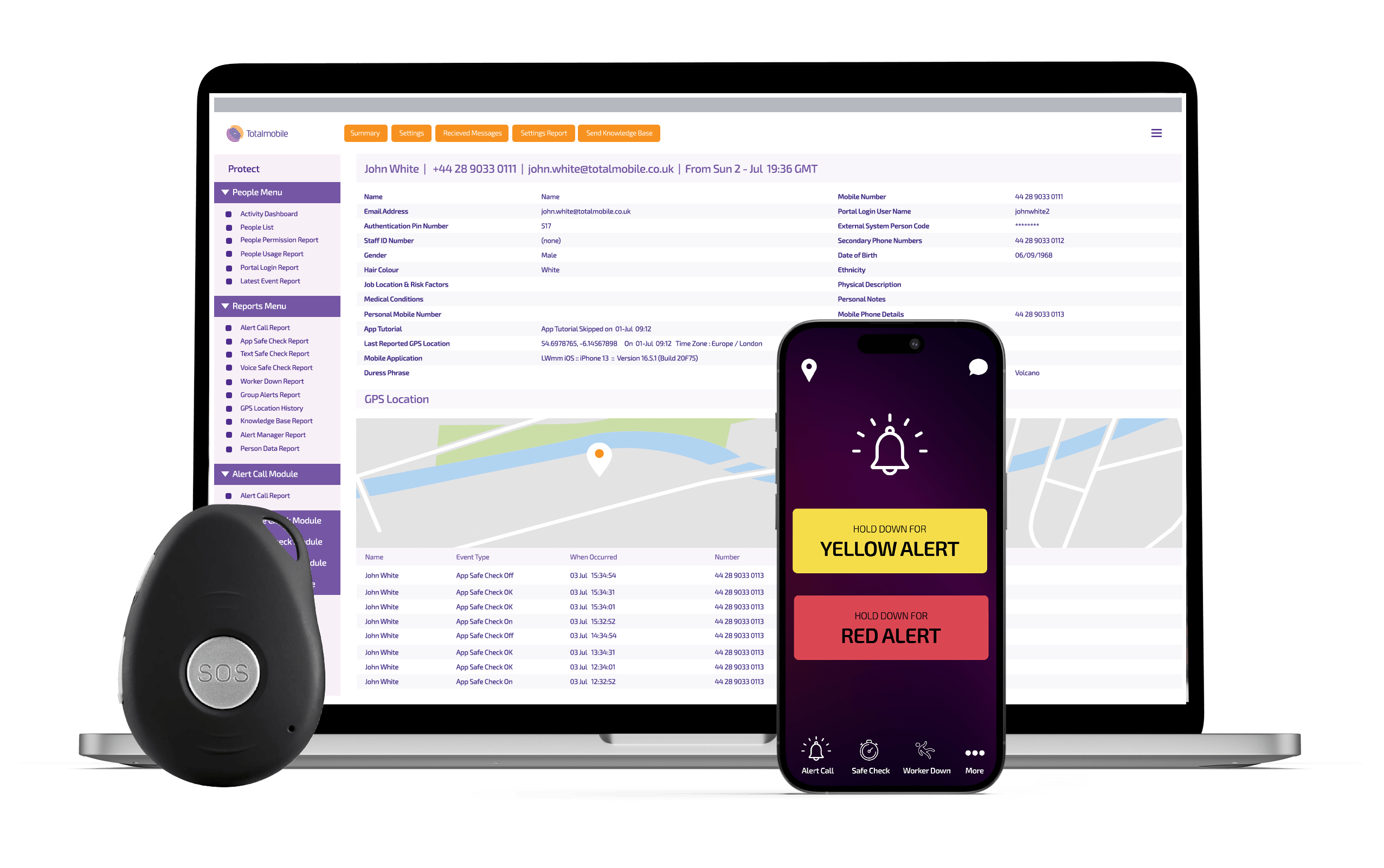Employee safety solutions play an important yet often unnoticed role in the safety culture of mobile workforces. They protect your frontline workforce, regardless of where they work or the work they complete. This enables you to:
Employee Safety
- Enhance remote workforce safety
- Increase operational compliance
- Mitigate against risk
- Improve perception as an employer of choice

This Guide Includes:
What is Employee Safety?
Employee safety refers to the measures, policies, and procedures put in place by employers to protect their workforce from hazards and risks in the workplace. These hazards could be physical, such as machinery or equipment, or environmental, such as exposure to harmful substances, great heights or extreme temperatures. These measures are also designed to safeguard your employees from psychological risks, including stress, harassment, and violence, helping to address vital health and safety concerns for the modern mobile workforce.
In the UK, nearly 600,000 workers sustain an injury at work each year, according to the Health and Safety Executive. These injuries not only affect the individual employees but also significantly impact the productivity and financial health of the organisations they work for.
Why Is Employee Safety Important?
Providing employees with a safe and healthy work environment is often called your ‘duty of care’. This duty of care is not just a legal obligation but should also be viewed as a crucial factor in the success of your business. It involves conducting regular risk assessments, implementing appropriate safety measures, providing training and education on safety practices, and maintaining open lines of communication for reporting hazards and incidents.
In the UK, this duty of care is particularly pressing in industries where frontline employees face significant risks. For example, in the property maintenance and construction sector, workers are often exposed to hazards related to heavy machinery, heights, and potentially dangerous materials. Similarly, in the healthcare sector, employees face risks ranging from exposure to infectious diseases to the physical strain of patient handling. The logistics industry also presents unique challenges, with employees often working with heavy goods vehicles, forklifts, and environments with high noise levels.
The Role of Technology in Employee Safety
Organisations across sectors are leveraging employee safety technologies to enhance safety protocols. These safety technologies range from wearable devices monitoring physical health to software solutions streamlining incident reporting and response. Employee safety technology is helping organisations better fulfil their duty of care, contributing to a safety-first culture where employees feel valued and protected.
What Value Do Employee Safety Solutions Provide Organisations?

Empowering and Equipping the Workforce
Employee safety solutions adopt a worker-first approach, prioritising the needs of your frontline technicians and field service workers. These solutions, whether specialised devices or dedicated apps, offer a direct link to assistance during times of need, providing comfort in distressing situations. Advanced GPS enables coordination with emergency services as required, offering additional protection and the ability to effectively manage and respond to situations. The visibility of worker location enhances employee safeguarding and safety with the ability to locate their whereabouts accurately.
Enhancing Communication and Visibility
Employee safety solutions significantly improve communication processes. With instant access to mobile devices for alert escalations or regular contact with colleagues, lone workers benefit from improved communication. This enhances their ability to carry out their jobs safely. Solutions like Protect connect lone workers to a state-of-the-art alarm receiving centre (ARC). High-quality, 2-way audio lets users talk directly to the ARC when they need support. This approach enhances security and fosters a sense of empowerment among the workforce while providing far more accurate detail to those responding to crises.


Assuring Compliance
Employee safety solutions help your organisation legally comply with safety regulations, protecting employee health and safety. Digital platforms can track regulatory changes, provide training modules to educate employees about these regulations and ensure that safety procedures are constantly followed. This helps organisations fulfil their duty of care and builds a culture of safety compliance. Real-time recording and updating of information also aid in auditing processes or in the case of an incident.
Attracting and Retaining Talent
Employee safety solutions can improve how workers view their employer. Offering a personal safety device as part of the employment contract can significantly increase your workforce’s willingness to take on new tasks, particularly those involving lone or public-facing work. This increase in role perception, coupled with improved employer perceptions, presents a direct and immediate solution to recruitment, engagement and retention challenges large mobile workforces face. Employees protected with safety solutions tend to feel more confident, engaged and happy in their roles.


Incident Reporting and Response
Solutions like Protect have revolutionised how organisations handle incident reporting and response. These platforms streamline reporting of safety incidents. This makes it easier for employees to communicate potential hazards, enabling organisations to respond promptly depending on severity. Advanced features may include real-time updates, automated alerts, and integration with emergency services, ensuring a swift and effective response when it matters most.
Safety Training and Education
Employee safety technology has revolutionised the delivery of safety training for mobile workforces. Online training modules, virtual reality simulations, and mobile apps have made safety education more accessible and engaging. This ensures that all mobile employees can access the resources they need to stay safe. These technological advancements promote a safety culture and provide real-time solutions for risk management.

Employee Safety FAQs
What are the five principles of safety?
The five principles of safety, often referred to as the “Hierarchy of Controls,” are:
Elimination: Removing the hazard completely from your workplace.
Substitution: Replacing a hazard with a less dangerous one.
Engineering Controls: Using technology to highlight potential risks and inform field service teams of hazards.
Administrative Controls: Changing how your people work, such as implementing safety procedures and providing training.
Personal Protective Equipment: Provide your remote workforce with lone worker protection devices, appropriate protective gear, distinct uniforms, gloves, safety glasses, or hard hats.
What does safety mean to a field service employee?
Safety for field service employees means performing their duties in an environment where their health and well-being are prioritised. This involves access to training, technology and tools that help prevent accidents and health issues caused by mobile working conditions.
How can employers improve safety for field service teams?
Service organisations can improve employee safety by conducting regular risk assessments. They can also provide safety training to ensure field teams can use personal protective equipment correctly. This fosters a culture of safety where employees feel comfortable reporting potential issues. This also extends to providing technology-driven employee safety solutions like Totalmobile’s Protect for large, blended mobile workforces.
What role do field workers play in maintaining safety?
Field workers play a crucial role in maintaining employee safety. They are responsible for following safety protocols, using personal protective equipment and technology properly, participating in safety training, reporting any unsafe conditions or practices, and contributing to a culture of safety in the workplace.
How does safety training benefit field service employees?
Safety training equips field technicians with the knowledge and skills to perform their jobs safely. It helps them understand potential hazards, how to use safety equipment properly, and what to do in an emergency. This can lead to fewer accidents and injuries, a safer work environment, and improved employee morale.
How can technology improve safety for field service employees?
Technology can enhance safety for field service employees in several ways. For example, advanced machinery can reduce the need for manual labour and the associated risks; safety apps can provide quick access to safety information; and wearable technology can provide real-time monitoring and emergency support.
What are the legal responsibilities of employers for employee safety?
Field service organisations are legally obligated to provide a safe and healthy work environment for their mobile employees. This includes conducting risk assessments to identify potential hazards and implementing safety measures to mitigate these risks. You can also provide safety training and equipment to comply with all safety standards. Employers must also legally report work-related injuries, diseases, and dangerous occurrences to the appropriate authorities.






